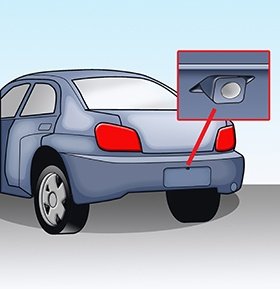Car manufacturers are mandated by law to have a rearview camera installed. However, finding the camera can be difficult at times. Also, you may need to make slight or massive adjustments to improve the field of view. Where is rear view camera located? Keep reading to find out.
Just as the name indicates, a rearview camera is located at the rear of the car. It is usually installed above the license plate mounting area or below the bumper. The mounting area determines its field of view and prevents it from damage. For example, mounting above the license plate protects it from weather elements. Nevertheless, the different mounting areas have distinct advantages and cons.
Choosing your camera mounting area is simple until you look at the pros and cons. This article will help you weigh both options and help you decide which is the best installation spot for any type of vehicle.
Table of Contents
HOW REAR VIEW CAMERAS WORK
A Rearview camera is a simple device to understand. If you own a car manufactured after May 2018, then it has an OEM rearview camera. It is initiated when the car is put in reserve. The camera mounted on the rear or sides of the car sends images to the monitor mounted on the dashboard or the rearview mirror located high on the dashboard. Advanced cameras are equipped with more features such as sensors to improve performance and for displaying high-quality images.
Unlike any normal camera, rearview cameras send a mirror image to the monitor so it has the same orientation as the reflection from rearview mirrors. This enables drivers to steer in the right direction. Advanced cameras also transmit high-resolution color images.
Wired cameras transmit high-resolution images with cables connected to both ends of the camera and monitor respectively. Wireless cameras on the other hand transform images into radio signals and back to images. Since there are no wires to transmit the images, it has to send radio signals, which the monitor decrypts and transforms back into image format to display on the screen.
LICENSE FRAME MOUNT
This is the most common spot for mounting a rearview camera. The installation is easy and it has better wiring throughout the car, from the license plate mounting area to the dashboard or rearview mirror. This mount uses the existing license plate screws
If your car is equipped with an OEM camera, then inspect the license plate area first. If you don’t find it there, check the bumper area.
Benefits Of License Frame Mount
The license frame mount is the most common type of rearview camera installation. This has numerous benefits and is inexpensive. Even when it’s beyond your budget, buying one will surpass your expectations and provide a longer Return on Investment. License frame mount protects against weather elements.
This further expands the lifespan of the camera. This type of frame mount has a better field of view. And doesn’t require modifications. You don’t have to drill your vehicles or make any sort of adjustments to install this type of rearview camera.
Cons:
It is near the road, so it may reduce the field of view.
SURFACE-MOUNT
The next type of rearview installation is the surface. It is self-contained in its casing and comes equipped with a mounting bracket. It is durable and weather-resistant. This type is mounted high and more suitable for bigger vehicles such as SUVs, jeeps, and trucks.
Benefits Of Surface Mount
This type of mount has several benefits, including a better field of view of your car rear and easy installation for just anyone, notwithstanding their level of technical knowledge.
FLUSH-MOUNT
The flush mount is another satisfactory installation type. It is common among motorists with small, compact, and passenger-style vehicles. This installation doesn’t rewire drilling or any sort of modification. Simply pass the cable through one of the numerous holes in your vehicle. The best installation area is the license plate. Unscrew the screws and pass the wires through the hole behind the license. The device is better protected as most of the body is located inside the vehicle, leaving only the lens outside.
Benefits of Flush-mount
There are several benefits of using the flush mount, including affordability. The installation is straightforward. Your camera is also protected as the body is inside. You can also modify the camera for high personalization. As a motorist, you may need to change the angle of the camera for a better field of view.
Cons:
Flush-mount has a smaller field of view, compared to other types of mounts.
DRILLED-MOUNT
The drilled mount requires tools to make a hole in your vehicle for passing the camera cables. Make sure the hole is small and doesn’t disfigure your vehicle. The hole can be drilled in the back or sides of your vehicle, depending on where you want to install the camera.
Benefits Of Drilled-Mount
Making a hole yourself helps you to properly measure the exact space required for installation. This makes it sturdy. It can also be mounted anywhere in your car.
Cons
You’ll have to make a hole in your car.
SHORT/LONG BUTTERFLY MOUNT
The last type is the short/long butterfly mount. This is mounted in the bumper or undercarriage of the vehicle. And is suitable for vehicles with a high base, such as RVs and trailers.
Benefits of Short/Long Butterfly Mount
There are several benefits of this type of mount, including a better field of view and no drills.
WHAT ARE THE TYPES OF REARVIEW MONITORS
The camera is constantly transmitting signal images to the monitor mounted on the dashboard. There are two types of rearview monitors: Stand-alone rearview monitors and rearview mirrors. They both have their distinct benefits and mode of installation.
Stand-Alone Rear View Cameras
Stand-alone rearview cameras are the most popular and can be found in both big and small vehicles. They are inexpensive, costing below $50. Nevertheless, they pack numerous benefits and come with an HDMI cable. Most are 7 inches and come with camera cables for easy installation. They are also remote-controlled. However, motorists have to get used to this new location as most of them look at the rearview mirror before locating the monitor.
Rear View Mirror
Another option is connecting the camera directly to the rearview mirror. Located high up on the windshield, this solution provides a better view for the motorists. It is also popular because motorists are used to the rearview mirror. Unlike popular belief, rrearview mirror installation is inexpensive and easy to install.
HOW TO MAINTAIN REAR VIEW CAMERA
Are you experiencing blur and want to clean your rearview camera? Then locate it first and apply one of the following maintenance methods below.
Clean the lens
Since the lens is outside the vehicle, dirt and water are always going to spill on it. These would cause blur over time, thereby reducing performance. To avoid blur, we recommend cleaning the lens every week or more, depending on the terrain of your regular commune. Motorists use isopropyl alcohol with a soft fabric for removing grime. The cloth is to prevent scratches.
Trace the wire
If there are still traces of blur after cleaning your lens with a chemical, then trace the cables from the camera to the monitor to find any damage or broken part. The most common cable damage is split or disconnected wires. Use tape to cover any open area. Replace old and worn-out cables with new and stronger cables for a reasonable price. Blown-out fuses are also common accurate, so check the fuse box and replace any blown out box with a new one.
Conclusively, rearview cameras are located on the license frame, undercarriage, and the side of a car. They can be installed through existing holes in your vehicle, on the license plate, or by drilling a hole in a suitable area in your car.




